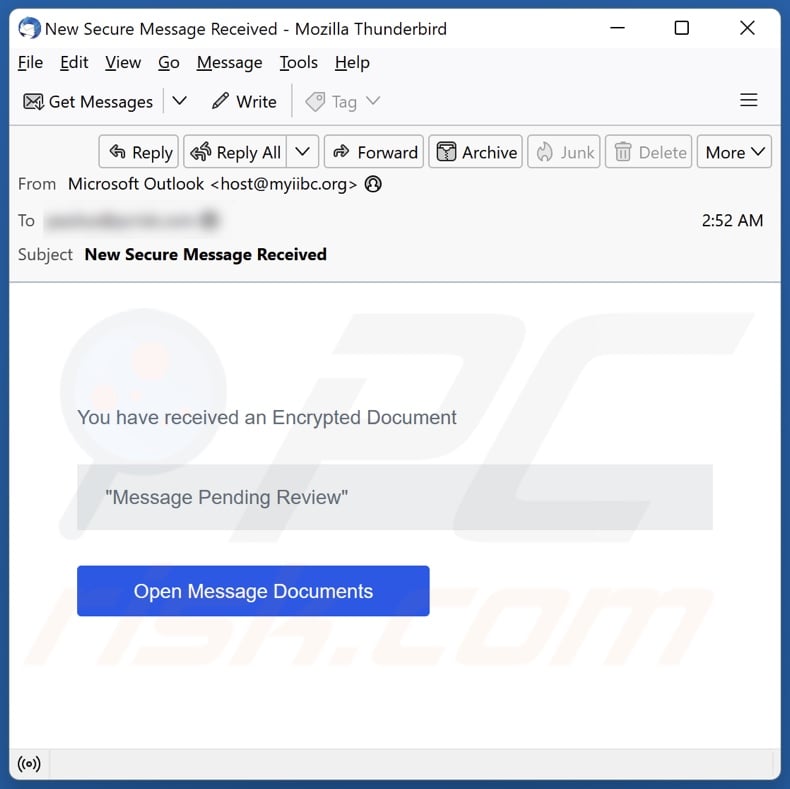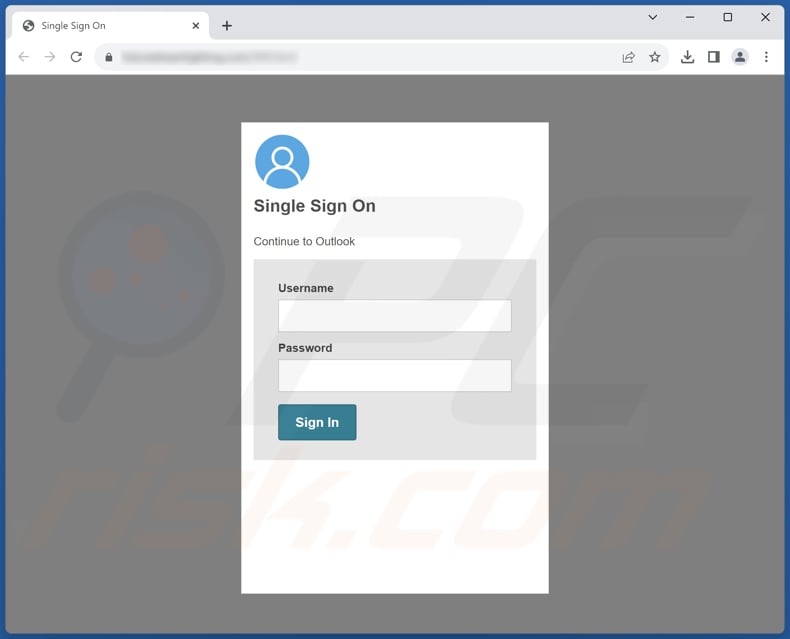
To use full-featured product, you have to purchase a license for Combo Cleaner. Seven days free trial available. Combo Cleaner is owned and operated by Rcs Lt, the parent company of PCRisk.com read more.
After inspecting the "You Have Received An Encrypted Document" email, we determined that it is spam. This letter makes false claims about a document shared with the email recipient. The goal is to trick them into visiting a phishing site presented as a sign-in page.

The email with the subject "New Secure Message Received" (may vary) states that an encrypted document has been received. When the "Open Message Documents" button is clicked, the user is redirected to a phishing website. The fake sign-in page records entered log-in credentials (i.e., usernames/passwords) and sends the information to scammers.
Emails are of particular interest to cyber criminals since they are used to register other accounts, platforms, and services. Hence, through a compromised email – access may be achieved to linked content.
To expand upon the harm that may be caused, scammers can steal the identities of social account owners (e.g., emails, social networking, social media, messengers, chats, etc.) and ask the contacts/friends/followers for loans or donations, promote scams, and proliferate malware by sharing malicious files or links.
Hijacked finance-related accounts (e.g., online banking, e-commerce, cryptocurrency wallets, etc.) can be used to make unauthorized transactions and/or online purchases. While any confidential/compromising content found on data storage or similar platforms could be used for blackmail or other malicious purposes.
To summarize, by trusting an email like "You Have Received An Encrypted Document" – users can experience serious privacy issues, financial losses, and even identity theft.
To eliminate possible malware infections, scan your computer with legitimate antivirus software. Our security researchers recommend using Combo Cleaner.
▼ Download Combo Cleaner
To use full-featured product, you have to purchase a license for Combo Cleaner. 7 days free trial available. Combo Cleaner is owned and operated by Rcs Lt, the parent company of PCRisk.com read more.
Phishing scams primarily target log-in credentials, personally identifiable details, and finance-related data. However, other scams are promoted through spam emails as well. Furthermore, this mail is used to spread malware.
While infamous for being riddled with grammatical and spelling errors, these emails can be elaborately disguised as messages from legitimate companies, organizations, service providers, authorities, and other entities.
Spam emails/messages may include malicious files as attachments or download links. These files can be documents (PDF, Microsoft Office, Microsoft OneNote, etc.), executables (.exe, .run, etc.), archives (RAR, ZIP, etc.), JavaScript, and so forth.
Once an infectious file is executed, run, or otherwise opened – the malware download/installation chain is initiated. However, some formats may need additional interaction to jumpstart system infection processes. For example, Microsoft Office files require users to enable macro commands (i.e., editing/content), while OneNote documents need them to click on embedded files or links.
We highly recommend exercising caution with incoming emails, DMs/PMs, SMSes, and other messages. Attachments or links found in suspicious mail must not be opened, as they can be virulent. We also recommend using post-2010 Microsoft Office versions since their "Protected View" mode prevents automatic macro execution.
It must be mentioned that malware is not proliferated only via spam mail. Therefore, we advise being careful while browsing, as fraudulent and malicious online content usually appears legitimate and harmless.
Another recommendation is to download only from official and verified sources. Additionally, all programs must be activated and updated using functions/tools provided by genuine developers, as illegal activation tools ("cracks") and third-party updates may contain malware.
We must emphasize the importance of having a reputable anti-virus installed and kept updated. This software must be used to perform regular system scans and to remove detected threats/issues. If you've already opened malicious attachments, we recommend running a scan with Combo Cleaner Antivirus for Windows to automatically eliminate infiltrated malware.
Text presented in the "You Have Received An Encrypted Document" spam email letter:
Subject: New Secure Message Received
You have received an Encrypted Document
"Message Pending Review"
Open Message Documents
Screenshot of the phishing website promoted by the "You Have Received An Encrypted Document" spam campaign:

Instant automatic malware removal: Manual threat removal might be a lengthy and complicated process that requires advanced IT skills. Combo Cleaner is a professional automatic malware removal tool that is recommended to get rid of malware. Download it by clicking the button below:
▼ DOWNLOAD Combo Cleaner By downloading any software listed on this website you agree to our Privacy Policy and Terms of Use. To use full-featured product, you have to purchase a license for Combo Cleaner. 7 days free trial available. Combo Cleaner is owned and operated by Rcs Lt, the parent company of PCRisk.com read more.
Quick menu:
Phishing Emails
Most commonly, cybercriminals use deceptive emails to trick Internet users into giving away their sensitive private information, for example, login information for various online services, email accounts, or online banking information.
Such attacks are called phishing. In a phishing attack, cybercriminals usually send an email message with some popular service logo (for example, Microsoft, DHL, Amazon, Netflix), create urgency (wrong shipping address, expired password, etc.), and place a link which they hope their potential victims will click on.
After clicking the link presented in such email message, victims are redirected to a fake website that looks identical or extremely similar to the original one. Victims are then asked to enter their password, credit card details, or some other information that gets stolen by cybercriminals.
Emails with Malicious Attachments
Another popular attack vector is email spam with malicious attachments that infect users' computers with malware. Malicious attachments usually carry trojans that are capable of stealing passwords, banking information, and other sensitive information.
In such attacks, cybercriminals' main goal is to trick their potential victims into opening an infected email attachment. To achieve this goal, email messages usually talk about recently received invoices, faxes, or voice messages.
If a potential victim falls for the lure and opens the attachment, their computers get infected, and cybercriminals can collect a lot of sensitive information.
While it's a more complicated method to steal personal information (spam filters and antivirus programs usually detect such attempts), if successful, cybercriminals can get a much wider array of data and can collect information for a long period of time.
Sextortion Emails
This is a type of phishing. In this case, users receive an email claiming that a cybercriminal could access the webcam of the potential victim and has a video recording of one's masturbation.
To get rid of the video, victims are asked to pay a ransom (usually using Bitcoin or another cryptocurrency). Nevertheless, all of these claims are false - users who receive such emails should ignore and delete them.
While cyber criminals try to make their lure emails look trustworthy, here are some things that you should look for when trying to spot a phishing email:
To minimise the risk of opening phishing and malicious emails we recommend using Combo Cleaner Antivirus for Windows.
Example of a spam email:

Why did I receive this email?
Spam emails are not personal. They are sent out in massive operations – hence, thousands of users receive identical messages.
I have provided my personal information when tricked by this spam email, what should I do?
If you have disclosed your account credentials – immediately change the passwords of all possibly exposed accounts and inform their official support. And if you've provided other private data (e.g., ID card details, passport scans/photos, credit card numbers, etc.) – contact the appropriate authorities without delay.
I have read a spam email but didn't open the attachment, is my computer infected?
Opening/Reading an email will not trigger any system infection processes. Devices are infected when malicious attachments or links are opened/clicked.
I have downloaded and opened a file attached to a spam email, is my computer infected?
Whether your device was infected might depend on the opened file's format. If it was an executable (.exe, .run, etc.) – most likely, yes. However, you might have avoided an infection if it was a document (.doc, .xls, .one, .pdf, etc.). These formats might need additional actions to initiate malware download/installation chains (e.g., enabling macro commands, clicking embedded files/links, etc.).
Will Combo Cleaner remove malware infections present in email attachments?
Yes, Combo Cleaner can detect and eliminate most of the known malware infections. It must be stressed that running a complete system scan is essential since sophisticated malicious software typically hides deep within systems.

Tomas Meskauskas - expert security researcher, professional malware analyst.
I am passionate about computer security and technology. I have an experience of over 10 years working in various companies related to computer technical issue solving and Internet security. I have been working as an author and editor for pcrisk.com since 2010. Follow me on Twitter and LinkedIn to stay informed about the latest online security threats. Contact Tomas Meskauskas.
PCrisk security portal is brought by a company RCS LT. Joined forces of security researchers help educate computer users about the latest online security threats. More information about the company RCS LT.
Our malware removal guides are free. However, if you want to support us you can send us a donation.
About PCriskPCrisk is a cyber security portal, informing Internet users about the latest digital threats. Our content is provided by security experts and professional malware researchers. Read more about us.
New Removal GuidesGlobal malware activity level today:

Increased attack rate of infections detected within the last 24 hours.
Top Removal GuidesScan this QR code to have an easy access removal guide of "You Have Received An Encrypted Document" phishing email on your mobile device.
We Recommend:Get rid of Windows malware infections today:
Platform: Windows
![]()
Editors' Rating for Combo Cleaner:
Outstanding!
To use full-featured product, you have to purchase a license for Combo Cleaner. 7 days free trial available. Combo Cleaner is owned and operated by Rcs Lt, the parent company of PCRisk.com read more.
Copyright © 2007-2024 PCrisk.com. Any redistribution or reproduction of part or all of the contents in any form is prohibited.
This website uses cookies to ensure you get the best experience on our website. Read our privacy policy